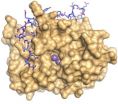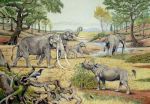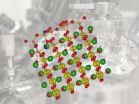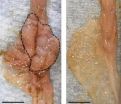(Press-News.org) Keck School of Medicine of USC neuroscientists have unlocked a piece of the puzzle in the fight against Lou Gehrig's disease, a debilitating neurological disorder that robs people of their motor skills. Their findings appear in the March 3, 2014, online edition of the Proceedings of the National Academy of Sciences of the United States of America, the official scientific journal of the U.S. National Academy of Sciences.
"We know that both people and transgenic rodents afflicted with this disease develop spontaneous breakdown of the blood-spinal cord barrier, but how these microscopic lesions affect the development of the disease has been unclear," said Berislav V. Zlokovic, M.D., Ph.D., the study's principal investigator and director of the Zilkha Neurogenetic Institute at USC. "In this study, we show that early motor neuron dysfunction related to the disease in mice is proportional to the degree of damage to the blood-spinal cord barrier and that restoring the integrity of the barrier delays motor neuron degeneration. We are hopeful that we can apply these findings to the corresponding disease mechanism in people. "
In this study, Zlokovic and colleagues found that an experimental drug now being studied in human stroke patients appears to protect the blood-spinal cord barrier's integrity in mice and delay motor neuron impairment and degeneration. The drug, an activated protein C analog called 3K3A-APC, was developed by Zlokovic's start-up biotechnology company, ZZ Biotech.
Lou Gehrig's disease, also called amyotrophic lateral sclerosis, or ALS, attacks motor neurons, which are cells that control the muscles. The progressive degeneration of the motor neurons in ALS eventually leads to paralysis and difficulty breathing, eating and swallowing.
According to The ALS Association, approximately 15 people in the United States are diagnosed with ALS every day. It is estimated that as many as 30,000 Americans live with the disease. Most people who develop ALS are between the ages of 40 and 70, with an average age of 55 upon diagnosis. Life expectancy of an ALS patient averages about two to five years from the onset of symptoms.
ALS's causes are not completely understood, and no cure has yet been found. Only one Food and Drug Administration-approved drug called riluzole has been shown to prolong life by two to three months. There are, however, devices and therapies that can manage the symptoms of the disease to help people maintain as much independence as possible and prolong survival.
INFORMATION:
The international research team included scientists from the The Scripps Research Institute, University of Rochester Medical Center, Sichuan University's West China Hospital, and Ludwig Institute for Cancer Research at the University of California, San Diego. Grants from The ALS Association (1859) and National Institutes of Health (AG039452, AG23084, NS34467, HL031950, HL052246, NS27036) supported their research.
Article cited:
Winkler, E. A., Sengillo, J. D., Sagare, A. P., Zhao, Z., Ma, Q., Zuniga, E., … & Zlokovic, B. V. (2014). PNAS Early Edition, 1-8. Published online March 3, 2014; doi:10.1073/pnas.1401595111
ABOUT KECK MEDICINE OF USC
Keck Medicine of USC is the University of Southern California's medical enterprise, one of only two university-owned academic medical centers in the Los Angeles area. Encompassing academic, research and clinical entities, it consists of the Keck School of Medicine of USC, the region's first medical school; the renowned USC Norris Comprehensive Cancer Center, one of the first comprehensive cancer centers established in the United States; the USC Care Medical Group, the medical faculty practice; the Keck Medical Center of USC, which includes two acute care hospitals: 401-licensed bed Keck Hospital of USC and 60-licensed bed USC Norris Cancer Hospital; and USC Verdugo Hills Hospital, a 158-licensed bed community hospital. It also includes outpatient facilities in Beverly Hills, downtown Los Angeles, La Cañada Flintridge, Pasadena, and the USC University Park Campus. USC faculty physicians and Keck School of Medicine departments also have practices throughout Los Angeles, Orange and Riverside counties. The Keck Medicine of USC world-class medical facilities are staffed by nearly 600 physicians who are faculty at the renowned Keck School of Medicine of USC and part of USC Care Medical Group. They are not only clinicians, but cutting-edge researchers, leading professors and active contributors to national and international professional medical societies and associations.
Experimental stroke drug also shows promise for people with Lou Gehrig's disease
New Keck School of Medicine of USC research finds vascular damage in mice with ALS contributes to early development of the neurodegenerative disease, while repairing damage delays disease progression
2014-03-03
ELSE PRESS RELEASES FROM THIS DATE:
Big stride in understanding PP1, the ubiquitous enzyme
2014-03-03
PROVIDENCE, R.I. [Brown University] — In the Proceedings of the National Academy of Sciences, a team of scientists at Brown University reports a major step forward in determining the specific behavior of the ubiquitous enzyme PP1 implicated in a wide range of diseases including cancer.
PP1, whose role is to enable the passage of molecular messages among cells, is found pretty much everywhere in the body. Its wide range of responsibilities means it is essential to many healthy functions and, when things go wrong, to diseases. But its very versatility has prevented it from ...
Mount Sinai study points to new biological mechanisms, treatment paradigm for kidney disease
2014-03-03
New York, NY – Prevention and reversal of chronic kidney disease is an urgent public health need. The disease affects 1 in 10 Americans, is debilitating and deadly, and existing drugs, at best, offer only mild delay in progression to end-stage kidney failure. New research led by Icahn School of Medicine at Mount Sinai investigators has uncovered abnormal molecular signaling pathways from disease initiation to irreversible kidney damage, kidney failure, and death. Results from their preclinical and human research are published online March 3 in the Journal of Clinical Investigation.
"Our ...
Researchers identify 'carbohydrates in a coal mine' for cancer detection
2014-03-03
Researchers at New York University and the University of Texas at Austin have discovered that carbohydrates serve as identifiers for cancer cells. Their findings, which appear in the journal Proceedings of the National Academy of Sciences, show how these molecules may serve as signals for cancer and explain what's going on inside these cells, pointing to new ways in which sugars function as a looking glass into the workings of their underlying structures.
"Carbohydrates can tell us a lot about what's going on inside of a cell, so they are potentially good markers for ...
New discovery solves problem of anti-inflammatory substance
2014-03-03
There have been great expectations regarding the production of a drug to block the enzyme LTA4 hydrolase, which plays a key role in the body's inflammatory response. However, in clinical trials, such molecules have proven to be only moderately effective. Now, researchers at Karolinska Institutet have successfully refined their understanding of why previous substances have been less effective – and in so doing have produced a molecule that gets around the problem. Consequently, there is once again hope of a new anti-inflammatory drug based on the principal of blocking LTA4 ...
Large mammals were the architects in prehistoric ecosystems
2014-03-03
Researchers from Denmark demonstrate in a study that the large grazers and browsers of the past created a mosaic of varied landscapes consisting of closed and semi-closed forests and parkland. The study will be published on Monday 3 March 2014 in the renowned journal PNAS (Proceedings of the National Academy of Sciences of the United States of America).
Dung beetles recount the nature of the past
The biologists behind the new research findings synthesized decades of studies on fossil beetles, focusing on beetles associated with the dung of large animals in the past ...
Electronics based on a 2-D electron gas
2014-03-03
Usually, microelectronic devices are made of silicon or similar semiconductors. Recently, the electronic properties of metal oxides have become quite interesting. These materials are more complex, yet offer a broader range of possibilities to tune their properties. An important breakthrough has now been achieved at the Vienna University of Technology: a two dimensional electron gas was created in strontium titanate. In a thin layer just below the surface electrons can move freely and occupy different quantum states.
Strontium titanate is not only a potential future alternative ...
Gut microbes spur development of bowel cancer
2014-03-03
It is not only genetics that predispose to bowel cancer; microbes living in the gut help drive the development of intestinal tumors, according to new research in mice published in the March issue of The Journal of Experimental Medicine.
Bowel cancer, also called colorectal cancer, results from a series of genetic changes (mutations) that cause healthy cells to become progressively cancerous, first forming early tumors called polyps that can eventually become malignant. Although mutations can occur anywhere in the human intestine, certain types of colorectal cancer tend ...
In academia, men more likely to cooperate with lower-ranked colleagues
2014-03-03
In academic circles at least, women tend to cooperate with same-sex individuals of higher or lower rank less often than men do. So say researchers who report evidence on March 3 in the Cell Press journal Current Biology. The findings are based on a study of the publication records of professors working at 50 North American universities.
"People are often upset to hear evidence of sex differences in behavior," says Joyce Benenson of Harvard University. "But the more we know, the more easily we can promote a fair society."
The findings might seem somewhat counterintuitive. ...
People with sleep apnea may be at higher risk of pneumonia
2014-03-03
People with sleep apnea appear to be at higher risk of pneumonia than people without, according to a study published in CMAJ (Canadian Medical Association Journal).
Sleep apnea is characterized by disrupted sleep, caused when the upper airway becomes obstructed by soft tissue, cutting off oxygen. It has been linked to several types of heart disease and cognitive impairment. People with obstructive sleep apnea are at higher risk of aspiration while sleeping.
To determine whether sleep apnea is linked to the development of pneumonia, Taiwanese researchers followed 34 ...
Calculating cooperation
2014-03-03
It's long been a popular stereotype: Men are hugely competitive, meaning cooperative effort is the exception rather than the norm, while women have a tendency to nurture relationships with others, making them much more likely to cooperate with one another.
A new Harvard study, however, is turning that cliché on its head.
In fact, within academic departments women of different social or professional "ranks" cooperate with each other less well than men do, according to Joyce Benenson, an Associate of Harvard's Human Evolutionary Biology Department and Professor of Psychology ...
LAST 30 PRESS RELEASES:
Tracing the quick synthesis of an industrially important catalyst
New software sheds light on cancer’s hidden genetic networks
UT Health San Antonio awarded $3 million in CPRIT grants to bolster cancer research and prevention efforts in South Texas
Third symposium spotlights global challenge of new contaminants in China’s fight against pollution
From straw to soil harmony: International team reveals how biochar supercharges carbon-smart farming
Myeloma: How AI is redrawing the map of cancer care
Manhattan E. Charurat, Ph.D., MHS invested as the Homer and Martha Gudelsky Distinguished Professor in Medicine at the University of Maryland School of Medicine
Insilico Medicine’s Pharma.AI Q4 Winter Launch Recap: Revolutionizing drug discovery with cutting-edge AI innovations, accelerating the path to pharmaceutical superintelligence
Nanoplastics have diet-dependent impacts on digestive system health
Brain neuron death occurs throughout life and increases with age, a natural human protein drug may halt neuron death in Alzheimer’s disease
SPIE and CLP announce the recipients of the 2025 Advanced Photonics Young Innovator Award
Lessons from the Caldor Fire’s Christmas Valley ‘Miracle’
Ant societies rose by trading individual protection for collective power
Research reveals how ancient viral DNA shapes early embryonic development
A molecular gatekeeper that controls protein synthesis
New ‘cloaking device’ concept to shield sensitive tech from magnetic fields
Researchers show impact of mountain building and climate change on alpine biodiversity
Study models the transition from Neanderthals to modern humans in Europe
University of Phoenix College of Doctoral Studies releases white paper on AI-driven skilling to reduce burnout and restore worker autonomy
AIs fail at the game of visual “telephone”
The levers for a sustainable food system
Potential changes in US homelessness by ending federal support for housing first programs
Vulnerability of large language models to prompt injection when providing medical advice
Researchers develop new system for high-energy-density, long-life, multi-electron transfer bromine-based flow batteries
Ending federal support for housing first programs could increase U.S. homelessness by 5% in one year, new JAMA study finds
New research uncovers molecular ‘safety switch’ shielding cancers from immune attack
Bacteria resisting viral infection can still sink carbon to ocean floor
Younger biological age may increase depression risk in older women during COVID-19
Bharat Innovates 2026 National Basecamp Showcases India’s Most Promising Deep-Tech Ventures
Here’s what determines whether your income level rises or falls
[Press-News.org] Experimental stroke drug also shows promise for people with Lou Gehrig's diseaseNew Keck School of Medicine of USC research finds vascular damage in mice with ALS contributes to early development of the neurodegenerative disease, while repairing damage delays disease progression





